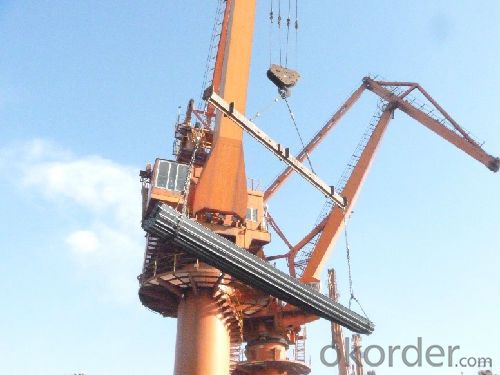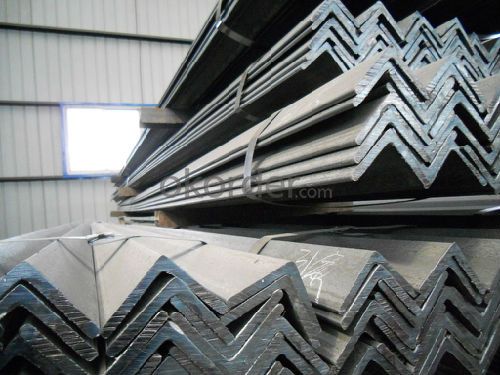JIS Standarder High Quality Angle Steel
- Loading Port:
- Tianjin
- Payment Terms:
- TT or LC
- Min Order Qty:
- 25 m.t.
- Supply Capability:
- 2000 m.t./month
OKorder Service Pledge
OKorder Financial Service
You Might Also Like
Product Description:
OKorder is offering Angle Steel great prices with worldwide shipping. Our supplier is a world-class manufacturer of steel, with our products utilized the world over. OKorder annually supplies products to European, North American and Asian markets. We provide quotations within 24 hours of receiving an inquiry and guarantee competitive prices.
Product Applications:
According to the needs of different structures, Angle can compose to different force support component, and also can be the connections between components. It is widely used in various building structures and engineering structures such as roof beams, bridges, transmission towers, hoisting machinery and transport machinery, ships, industrial furnaces, reaction tower, container frame and warehouse etc.
Product Advantages:
OKorder's Angle Steelare durable, strong, and resist corrosion.
Main Product Features:
· Premium quality
· Prompt delivery & seaworthy packing (30 days after receiving deposit)
· Corrosion resistance
· Can be recycled and reused
· Mill test certification
· Professional Service
· Competitive pricing
Product Specifications:
1. Invoicing on theoretical weight or actual weight as customer request
2. Length: 6m, 9m, 12m as following table
3. Sizes
Sizes: 25mm-250mm | ||
a*t | ||
25*2.5-4.0 | 70*6.0-9.0 | 130*9.0-15 |
30*2.5-6.6 | 75*6.0-9.0 | 140*10-14 |
36*3.0-5.0 | 80*5.0-10 | 150*10-20 |
38*2.3-6.0 | 90*7.0-10 | 160*10-16 |
40*3.0-5.0 | 100*6.0-12 | 175*12-15 |
45*4.0-6.0 | 110*8.0-10 | 180*12-18 |
50*4.0-6.0 | 120*6.0-15 | 200*14-25 |
60*4.0-8.0 | 125*8.0-14 | 250*25 |
Note:
1. According to national standard (GB) for our products, if not, supply according to national standards (GB) or agreement.
2. We can not only provide electric furnace +LF+VD and electro-slag re-melting (ESR)steel forging materials, but also forging products of piece, bar, etc.
3. Our company is equipped with roll equipment and can provide our customers with roll billets or finished.
4. Please send us your detailed specifications when inquire. We will reply to you ASAP.
Production Flow of High Quality Round Bar
The common processes are preheated forging quenching, dual refinement solution process, cooling quenching and isothermal quenching. We use heat treatment for dual refinement solution process. The main measures process is high temperature solution and refinement cycle. High temperature solution can improve the carbide morphology and particle size. The aim is to make the loop refinement ultrafine austenite grains.
FAQ:
Q1: Why buy Materials & Equipment from OKorder.com?
A1: All products offered byOKorder.com are carefully selected from China's most reliable manufacturing enterprises. Through its ISO certifications, OKorder.com adheres to the highest standards and a commitment to supply chain safety and customer satisfaction.
Q2: How do we guarantee the quality of our products?
A2: We have established an advanced quality management system which conducts strict quality tests at every step, from raw materials to the final product. At the same time, we provide extensive follow-up service assurances as required.
Q3: How soon can we receive the product after purchase?
A3: Within three days of placing an order, we will begin production. The specific shipping date is dependent upon international and government factors, but is typically 7 to 10 workdays.
Images:


- Q:How are steel angles measured?
- Steel angles are typically measured by their dimensions, including the length of each side and the thickness of the material. The measurement is usually given in inches or millimeters.
- Q:What is the difference between galvanized steel bar and ordinary angle iron?
- Durable: galvanized steel with surface gloss, zinc layer uniform, no plating leakage, without drip, strong adhesion characteristics, strong corrosion resistance, in a suburban environment, galvanized thickness standard can be maintained for more than 50 years without repair; in urban areas or coastal areas, the standard hot galvanized layer it can be maintained for 20 years without repair;
- Q:What is the standard size of steel angles?
- The standard size of steel angles can vary depending on the specific application and industry requirements. However, common standard sizes for steel angles typically range from 1/2 inch to 8 inches in width and height, with a thickness that can range from 1/8 inch to 1 inch.
- Q:Can steel angles be used for support columns?
- Indeed, support columns can utilize steel angles. In construction, steel angles are widely employed as structural elements, serving to offer support and stability for diverse building components. Their robustness, longevity, and load-bearing capacity make them particularly fitting for use as support columns. By virtue of their ability to be tailored and manufactured to meet specific structural needs, steel angles prove to be an excellent option for sustaining heavy loads or providing vertical support in different building applications. Furthermore, steel angles offer flexibility in terms of size, shape, and connection alternatives, enabling tailored column designs that effectively distribute loads and guarantee structural soundness. In summary, steel angles are a dependable and extensively utilized choice for support columns in various construction undertakings.
- Q:What is the corresponding length of the root weight in the angle standard?
- General fixed length delivery without weighing, no fixed length delivery is generally applied to weighing sales. Profile fixed length is generally divided into 6 meters, 9 meters and 12 meters, special sizing must be large quantities, consultation with the steel supply.
- Q:What are the common uses of equal steel angles?
- Equal steel angles are a versatile and commonly used structural component in various industries. Some of the common uses of equal steel angles include: 1. Construction: Equal steel angles are frequently used in construction projects, particularly for framing, support, and bracing structures. They are commonly used in the construction of buildings, bridges, and other infrastructure projects. 2. Manufacturing: Equal steel angles are also widely used in manufacturing industries, such as automotive, machinery, and shipbuilding. They are utilized in the fabrication of frames, chassis, supports, and various other structural components. 3. Shelving and Racking: Equal steel angles are often used in the construction of shelving and racking systems. They provide strength and stability to support heavy loads and are commonly used in warehouses, retail stores, and industrial facilities. 4. Fencing and Security: Equal steel angles are commonly used in the construction of fences and gates. They provide a strong and durable framework for securing properties, creating boundaries, and protecting assets. 5. Stairs and Handrails: Equal steel angles are frequently used in the construction of stairs and handrails. They provide support and stability to ensure safe and functional access to different levels in buildings, walkways, and outdoor structures. 6. Infrastructure and Utilities: Equal steel angles are utilized in various infrastructure and utility projects, including electrical transmission towers, telecommunications masts, and solar panel installations. They provide the necessary support and stability for these structures. 7. Agricultural and Farming: Equal steel angles are commonly used in the agricultural and farming industry for constructing fences, gates, and animal enclosures. They provide a durable and secure framework for containing livestock and protecting crops. 8. Decorative and Architectural: Equal steel angles are also used for decorative and architectural purposes. They can be utilized to create unique and aesthetically pleasing designs in buildings, furniture, and other decorative applications. Overall, equal steel angles have numerous applications across different industries due to their strength, versatility, and cost-effectiveness. Whether it is for construction, manufacturing, infrastructure, or decorative purposes, equal steel angles play a vital role in providing structural support and stability.
- Q:What are the different types of steel angles used in bridge construction?
- Some common types of steel angles used in bridge construction include equal leg angles, unequal leg angles, and L-shaped angles. These angles are often used to provide structural support and reinforcement in various bridge components, such as beams, columns, and bracings.
- Q:How do steel angles contribute to energy-efficient construction?
- There are multiple ways in which steel angles play a role in energy-efficient construction. To begin with, steel angles are frequently utilized as structural elements in buildings, particularly for framing walls, roofs, and floors. Their excellent strength-to-weight ratio enables the construction of lighter and more efficient structures. This means that less steel is required to support the building, resulting in reduced overall weight and material usage. Consequently, this leads to a decrease in the energy needed for construction and transportation. Furthermore, steel angles can be easily prefabricated off-site, which allows for quicker construction times and lower labor costs. This not only saves time and money but also reduces energy consumption during the construction process. Moreover, steel is an incredibly durable and long-lasting material, which reduces the necessity for frequent maintenance and repairs. This durability translates into energy savings throughout the building's lifespan, as less energy is required for ongoing maintenance and replacements. Additionally, steel angles can be recycled when they reach the end of their life cycle. This reduces the demand for new materials and minimizes the environmental impact of construction. The recycling process requires less energy compared to the production of new steel, resulting in energy savings and reduced greenhouse gas emissions. Lastly, steel angles can be integrated into energy-efficient building systems, such as insulation, HVAC ductwork, and renewable energy installations. The versatility of steel allows for the creation of systems that optimize energy performance, such as efficient heating and cooling systems or solar panel installations. In conclusion, steel angles contribute to energy-efficient construction through their strength and stability, reduced material usage, faster construction times, minimized maintenance needs, recycling capabilities, and integration with energy-efficient building systems.
- Q:Are steel angles suitable for architectural applications?
- Indeed, architectural applications are well-suited for steel angles. In construction and architectural projects, steel angles are frequently employed due to their adaptability, robustness, and visual allure. They serve a multitude of purposes, including the formation of structural frames, supports, connections, and even decorative elements. Architects are provided with a wide range of options when it comes to steel angles, as they are available in various sizes, thicknesses, and finishes, enabling the selection of the most appropriate choice in accordance with specific design requirements. Moreover, steel angles can be effortlessly welded, drilled, and manipulated to accommodate diverse angles and shapes, thus rendering them a versatile and economical alternative for architectural applications.
- Q:Can steel angles be used in railway infrastructure?
- Yes, steel angles can be used in railway infrastructure. They are commonly used in the construction of railway tracks, bridges, and other structures due to their high strength, durability, and ability to withstand heavy loads. Steel angles provide structural support and stability, making them an essential component in railway infrastructure projects.
1. Manufacturer Overview |
|
|---|---|
| Location | |
| Year Established | |
| Annual Output Value | |
| Main Markets | |
| Company Certifications | |
2. Manufacturer Certificates |
|
|---|---|
| a) Certification Name | |
| Range | |
| Reference | |
| Validity Period | |
3. Manufacturer Capability |
|
|---|---|
| a)Trade Capacity | |
| Nearest Port | |
| Export Percentage | |
| No.of Employees in Trade Department | |
| Language Spoken: | |
| b)Factory Information | |
| Factory Size: | |
| No. of Production Lines | |
| Contract Manufacturing | |
| Product Price Range | |
Send your message to us
JIS Standarder High Quality Angle Steel
- Loading Port:
- Tianjin
- Payment Terms:
- TT or LC
- Min Order Qty:
- 25 m.t.
- Supply Capability:
- 2000 m.t./month
OKorder Service Pledge
OKorder Financial Service
Similar products
New products
Hot products
Related keywords



























